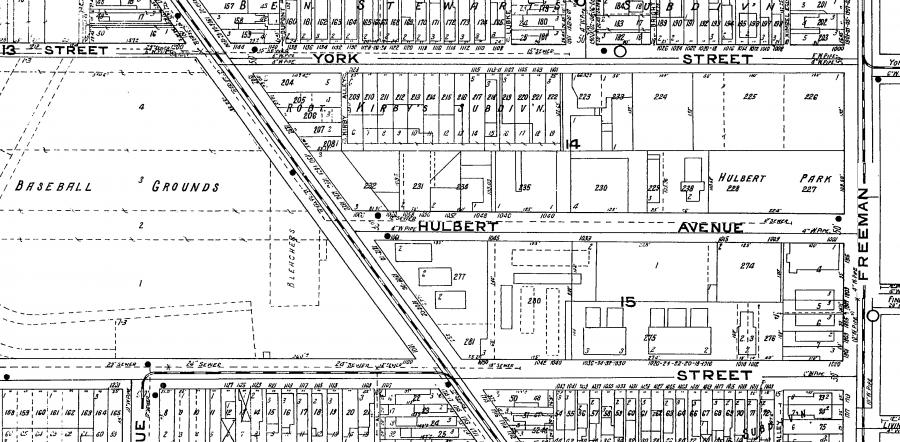
Image from Cincinnati Post 5 September 1913; Image extracted from microfilm by Greg Hand
Larry McGowan made quite an impression on the Cincinnati Post reporter who came to interview him in 1913. Unfortunately, it was not a very good impression.
“It is the opinion of the interviewer that if once in a while Larry is given a first-class spanking he will make a first-class man.”
Young Mister McGowan came to the attention of the Cincinnati Post because of the Hulbert Playground strike. The playground, at the northwest corner of Hulbert and Freeman avenues, was a relatively new park in 1913. Larry was the self-declared president of the Hulbert Ramblers, a gang of young boys who hung around the park. One day, he was evicted from the park. Larry, aged 15, said he was evicted because he complained some younger boys were bothering him. The park superintendent and a police officer said they objected to Larry’s language. Once Larry was evicted from Hulbert Playground, the Ramblers, about 30 in number, went on strike. The ramblers refused to enter the park and they prevented any other children from entering the park as well, sometimes using force.
“Clarence Cordes of 126 Hulbert-st. testified he was ‘trimmed by a gang’ when he used the playground apparatus several days ago. Rudolph Braun, another boy, said the strikers were intimidating others who wanted to visit the playground.”
Judge Frederick Hoffman, acting Juvenile Court magistrate, was unamused and ordered Larry to cease and desist. Larry assured the judge that he would ask his followers to end the strong-arm tactics.
The unnamed Post reporter found Larry at his mother’s house, 1917 Colerain Avenue, just around the corner from the park. Larry’s father, a bricklayer, was dead. He died eight years previously when a scaffold collapsed on a Fifth Street job site. The reporter expressed amazement at Larry’s vocabulary [5 September 1913]:
“Never before has a lad who spoke regular English had a chance to be the leader of his gang. Always it has been the custom of gangs to pick on the child who used words longer than one syllable but Larry McGowan, who can also fight, makes all of the West End stand back in awe and respect as he pulls large words. ‘I am surprised that the unfortunate incident in which I was involved has caused such excitement among the members of the press,’ said he. ‘You think, perhaps, I am a rough-neck. Your impression is erroneous.’”
Larry explained that he was a natural leader because of his intelligence, personality and Irish ancestry.
“I am in my second year at Woodward High School. I believe in education, and although I am pretty good at fighting, even though I say it myself, I am also good at mathematics, English, and I am reading some law. Intelligence is what counts these days.”
The headline proclaimed Larry the “Napoleon of Boyville.”

Larry McGowan’s battlefield, Hulbert Playground, had a brief and contentious existence. The park was once part of the estate of William P. Hulbert, a Cincinnati businessman and real estate developer. The Hulbert property was located just two blocks east of Crosley Field (then known as the Palace of the Fans). In 1911, the land was donated to the city for use as a playground by Hulbert’s daughter, Matilda (Mrs. Frank) Perin. The Perins lived in fashionable Clifton and Dad’s old homestead was in the declining West End.
For the next decade, despite a diligent mother’s club, the city parks department ignored Hulbert Playground, doing little more than erecting some basic equipment and a corrugated metal shelter. When the city floated a bond levy in 1915, the Hulbert Playground Mothers League mobilized to support it, but got nothing out of the levy for their park. Obvious preference went to parks located on the wealthier hilltops. The city claimed it had no money to support the little West End playground because it was land donated to the city. In the Cincinnati Post [27 September 1916] Catherine Dittmarr, president of the Hulbert Mothers, called bullshit:
“If the board has no money, how can it appropriate $40,000 for improvements in Ault Park? Because Hulbert playgrounds was a gift to the city the park board says that it can do nothing. Ault Park was also a gift to the city.”
By 1922, the city actually asked Mrs. Perin to sue so the city could give the park back to her because they had no interest in maintaining it. The land reverted to the Hulbert heirs, who sold it. The lot is now occupied by the National Flag Company headquarters and factory.
Larry McGowan, the erstwhile “Napoleon of Boyville,” enlisted in the United States Army to fight in World War I. He was sent to France where his unit, the 148th Infantry Regiment of the Ohio National Guard, saw combat in the Meuse-Argonne and Ypres-Lys offenses. Larry was discharged in 1919. He got a job as a traveling salesman.
In 1929, Larry married Mary Hazel Sternberg at Holy Name Church. The couple made a home on Beekman Street. Larry sold water heaters for the Humphrey Co., the local outlet for Ruud Manufacturing.
Larry and Hazel never had children In January 1938, the couple bought a house on West Liberty Street in Price Hill but, in December 1939, Larry died from kidney disease. Hazel applied for a veteran’s tombstone and it was placed over his grave in New St. Joseph cemetery.
This article was reposted with permission from Greg Hand, editor of Cincinnati Curiosities.




Facebook Comments